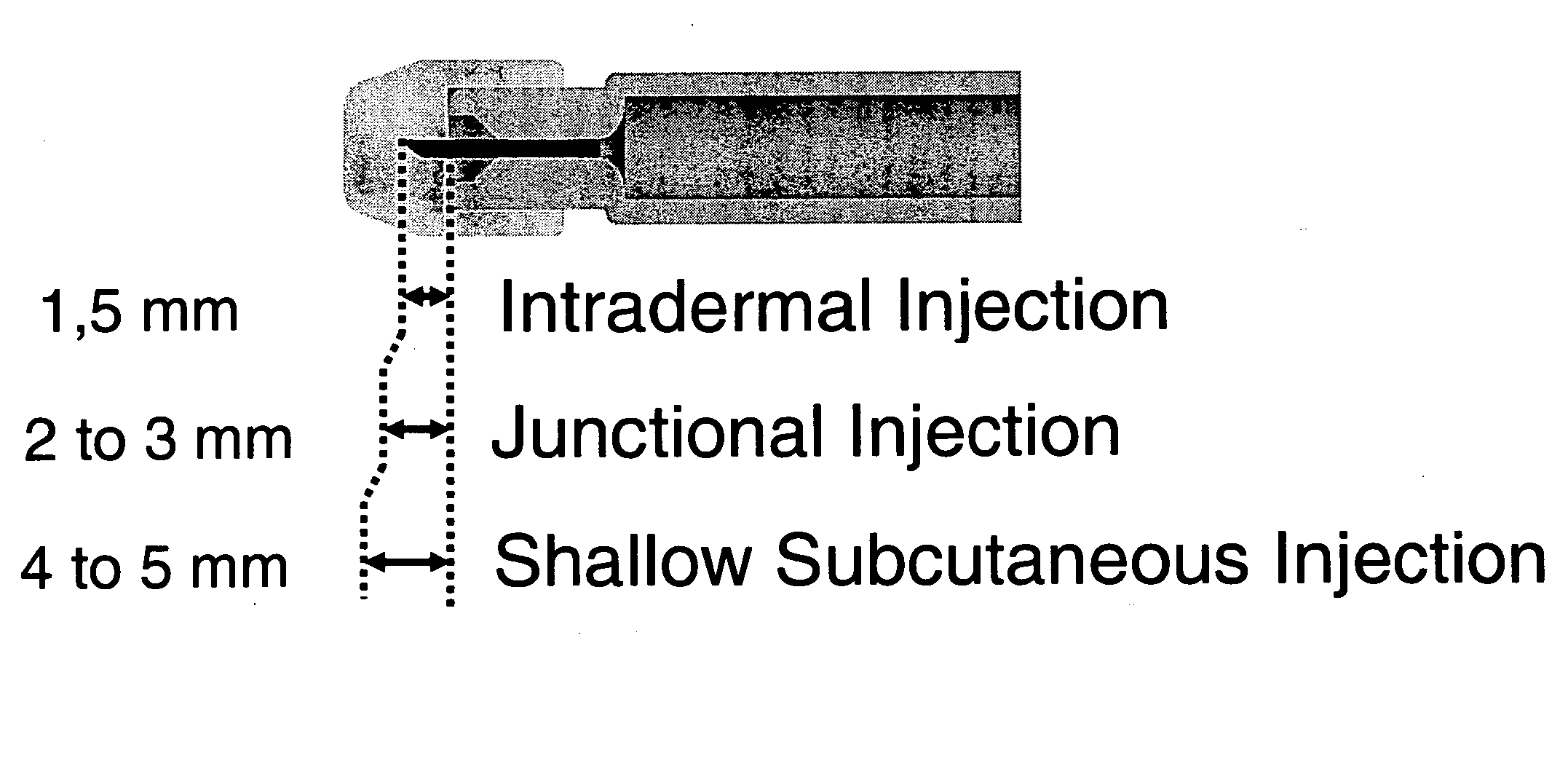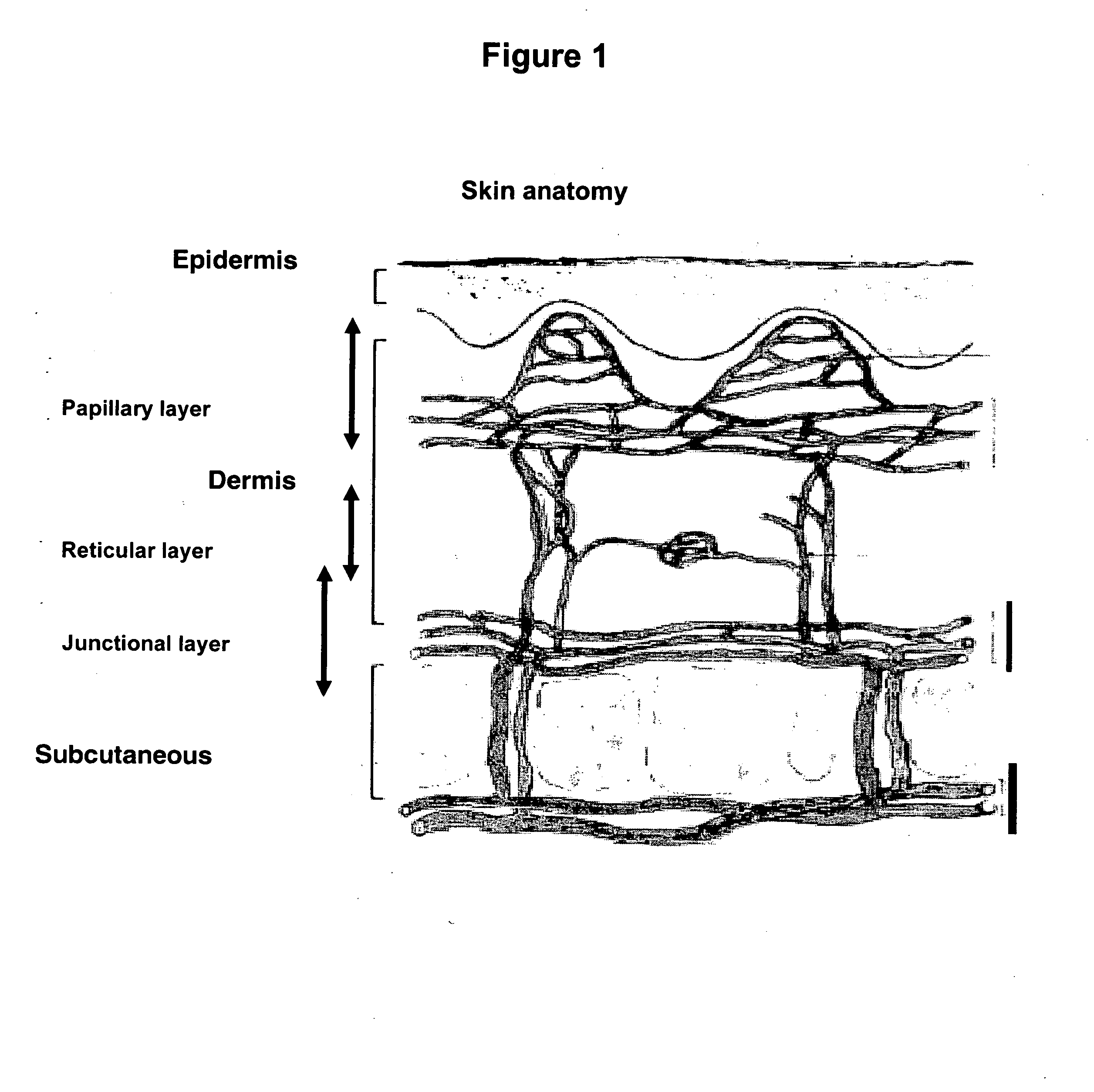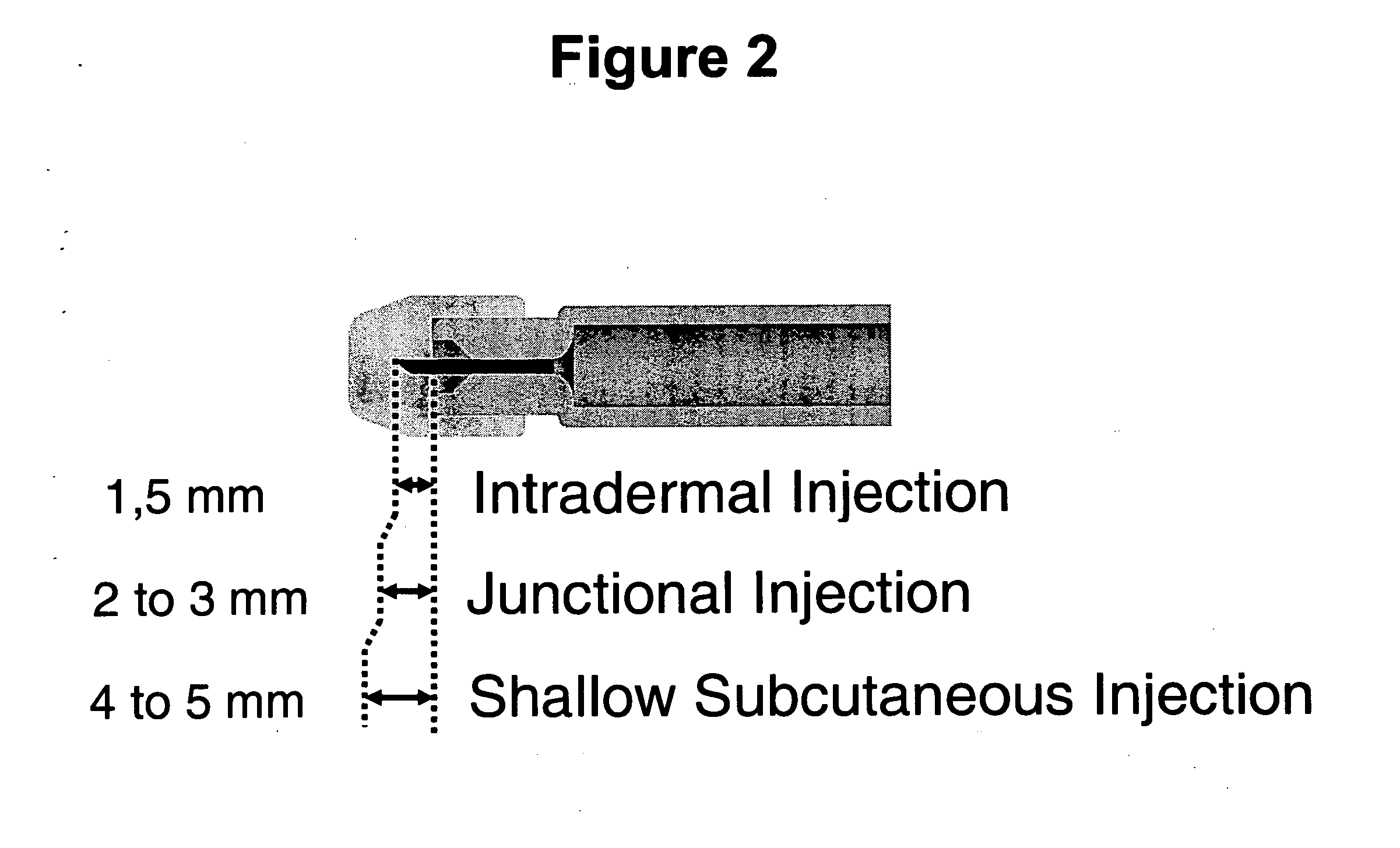[0008] The present invention provides a new parenteral administration method by selectively and specifically targeting the junctional layer of a subject's skin, thereby resulting in enhanced therapeutic
efficacy of the delivered substance. Substances delivered in accordance with the methods of the invention have an improved clinical utility and therapeutic
efficacy relative to other
drug delivery methods including intradermal and subcutaneous delivery. The present invention provides benefits and improvements over conventional
drug delivery methods including but not limited to improved
pharmacokinetics, reduction of undesired and harmful side-effects, reduction or
elimination of
pain perception by the subject, and absence of limitation on the volume of injection.
[0010] As used herein, administration into the junctional layer is intended to encompass administration of a substance into the junctional layer in such a manner that the substance is deposited in the junctional layer such that it readily reaches the dense network of venous
plexus and postcapillary veins of the junctional layer, and is rapidly absorbed and systemically distributed. In accordance with the methods of the invention, deposition of a substance into the junctional layer occurs predominately at a depth of at least about 1.5 mm, preferably, at least about 2 mm, up to a depth of no more than about 3 mm, preferably, no more than about 2.5 mm, which results in rapid absorption of the substance and reduced immune response. Therefore, the substances delivered in accordance with the methods of the invention may exert their beneficial effects more rapidly than other routes of administration, including ID and IM.
[0012] The present invention provides for targeting and deposition of a substance into the junctional layer of the skin. Delivering a substance into a subject's junctional layer in accordance with the methods of the invention results in improved
pharmacokinetics, e.g., an improved pharmacokinetic profile. Although not intending to be bound by a particular theory, it is believed that due to the dense network of venous
plexus and post-capillary veins that infiltrate the junctional layer, administering the substance directly into the junctional layer would result in a more efficient uptake of the substance than subcutaneous or intramuscular administration, which, in turn, would result in an improved
pharmacokinetics. Furthermore, by specifically and selectively targeting the junctional layer for the delivery, the pharmacokinetics exhibited by the substance is consistently reproducible, resulting in a reduced inter-individual variability of PK parameters relative to other conventional
delivery methods.
[0013] The methods of the present invention not only provide improved pharmacokinetics over conventional
drug delivery methods, but also provide additional benefits including a reduction in harmful side effects caused by the administration of a substance, such as an unwanted immune response and inadvertent immuno-toxic effect against the active ingredients of the substance. As used herein, the term “unwanted immune response” means the natural immune response of the subject receiving a substance of this invention, where the substance is not intended to provoke such response when administered. Examples of unwanted immune responses that may be prevented using the methods of the invention include, but are not limited to, IgE-mediated hypersensitivity, with the risk of local and / or systemic
anaphylactic reaction as described, for instance, after parenteral injection of
insulin or
heparin and many other drugs based on having a
protein or a
polysaccharide as the
active ingredient;
antibody-mediated cytotoxic hypersensitivity as well as
immune complex mediated hypersensitivity that cause systemic adverse events, such as
kidney and / or liver and / or microvascular alteration due to the deposition of circulating immune complexes;
cell-mediated hypersensitivity with the risk of inducing delayed type reaction at the
injection site and immune
neutralization of the
active ingredient, or any systemic adverse event, such as thrombocytopenia induced by
heparin treatment.
[0014] The methods of the invention are thus particularly useful for the delivery of therapeutic substances to which the induction of an immune response would not be beneficial to the
therapeutic effect of the substance to be delivered. Examples of such substances include low molecular weight heparins, pentasaccharides,
interferon alpha and beta, erythropoeitines, antibodies, polypeptidic hormones,
growth hormone, and interleukins. The
reduced risk of immuno-toxic effect in accordance with the
delivery methods of the invention is due, in part, to the low preponderance of immunocompetent cells in the junctional layer. Therefore, the methods of the invention are preferred over intradermal delivery of such substances, where the risk of unwanted immune response is higher since the intradermal space is characterized by a
high concentration of immunocompetent cells, e.g., dendritic cells, monocytes, lymphocytes, macrophages, etc. In a specific embodiment, the substance to be administered in accordance with the methods of the invention is not a vaccine, for which minimizing immune response may be unfavorable.
[0015] Delivering a substance in accordance with the methods of the invention reduces or eliminates pain perceived by the subject. Therefore, the methods of the instant invention are preferred to other parenteral delivery methods, including intradermal delivery. Although not intending to be bound by a particular
mechanism of action, the intradermal layer is a
sensory organ characterized by nerve endings and nervous corpuscles. In contrast, the junctional layer has poor nerve endings and sensory corpuscles, and thus the
pain perception induced by the administration of a substance into the junctional layer is lower than that perceived by delivering the substance to the intradermal layer.
 Login to View More
Login to View More  Login to View More
Login to View More 


